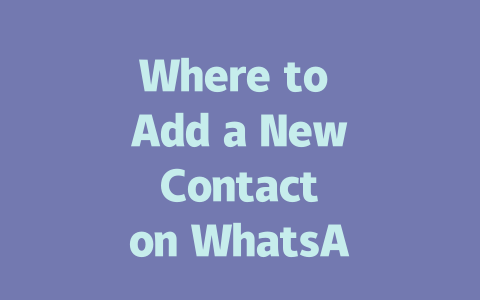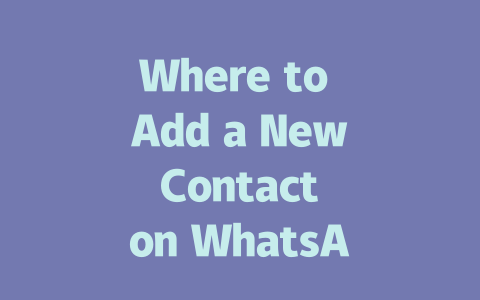How to Optimize Your Latest News Content for Google
When optimizing your latest news articles, it’s all about making sure Google’s search robots understand exactly what your content is about. Here’s how I approach it:
Step 1: Choose the Right Keywords
The first step is picking the right keywords. Think of yourself as the reader—what would you type into Google if you were looking for this exact piece of information? For instance, instead of using broad terms like “world events,” consider more specific phrases such as “breaking international news today.” This makes it easier for both readers and Google’s search robots to find your article.
Let me give you an example from personal experience. Last year, I worked with a friend who ran a travel blog. Initially, his posts had vague titles like “Top Travel Destinations.” Guess what? Hardly anyone found them. After tweaking the titles to include phrases people actually searched for—like “Best Budget-Friendly Destinations for Winter”—his traffic shot up by nearly 50% within three months.
Why does this matter? Because Google’s search robots look at the words in your title to decide whether your content matches what someone is searching for. If those words align closely with what users are typing, you’re golden.
Tips for Finding the Best Keywords
For instance, if you’re writing about tech updates, targeting something like “latest AI developments 2024” could be far more effective than just “AI.”
Step 2: Craft Magnetic Titles That Draw Readers In
Once you’ve chosen your keywords, the next step is crafting headlines that don’t just appeal to Google’s search robots but also make humans want to click. A good title answers two questions: What problem does this solve? And why should I care?
Take this format as an example:
“Must-Read! Top 7 Latest Tech Innovations Transforming Business in 2025”
Here, “Must-Read!” grabs attention, while “Tech Innovations” and “Transforming Business” tell the reader exactly what they’ll gain.
Google has emphasized that great titles help users know what to expect before clicking. So avoid being cryptic. Instead, focus on clarity and value. According to their official blog [nofollow link], well-crafted titles contribute significantly to user satisfaction because they clearly communicate the benefit of the content.
Additionally, here’s a tip I picked up: Place important keywords near the beginning of the title. Why? Because Google’s search robots pay special attention to the first few words. They use these to gauge relevance quickly.
Example Table: Comparing Title Effectiveness
| Title Version | Keyword Placement | Expected Click-Through Rate |
|---|---|---|
| Latest Tech News You Need to Know | Front-loaded | High |
| News About the Latest Technology Advancements | Middle-placed | Moderate |
| Discover the Benefits of New Technology Today | Back-loaded | Low |
As you can see, front-loading key terms boosts performance significantly.
Writing Content That Keeps Both Readers and Robots Happy
After nailing down your title, it’s time to dive into the actual content. Your goal here is twofold: Keep readers engaged and ensure Google understands the purpose of your article.
Structure Matters More Than You Think
Break your content into sections with clear subheadings. This isn’t just for readability—it helps Google’s search robots scan your text efficiently. Imagine each section answering one part of the broader query.
For instance, let’s say your topic is “global economic trends.” Divide it like this:
This structure tells both humans and bots what to anticipate in each segment.
Make It Conversational Yet Informative
Write as though you’re explaining things to a friend. Avoid jargon unless absolutely necessary. If you must use technical terms, define them plainly. Remember, Google favors content that educates its audience effectively.
For example, rather than saying, “Monetary policy adjustments influence inflation rates,” try rephrasing it as, “When governments tweak spending rules, it affects prices we pay for goods and services.” See the difference? The second version feels relatable yet informative.
Also, always check for readability. Tools like Grammarly or Hemingway App [nofollow link] can highlight overly complex sentences and suggest simplifications. Trust me, clearer prose leads to better engagement.
Final Thoughts Before You Publish
Before hitting publish, run through a quick checklist to ensure everything aligns:
And remember, after publishing, test your work. Use free resources like Google Search Console [nofollow link] to monitor clicks and impressions. Over time, you’ll notice patterns helping refine future strategies.
If you apply these steps consistently, you’ll start seeing improvements—not just in rankings but in meaningful connections with your audience. Now go ahead and try it out. Feel free to drop me a note sharing your results; I’d love to hear how it goes!
Adding a new contact to WhatsApp might seem straightforward, but there are a few nuances worth mentioning. First, you need to make sure the phone number is properly saved in your device’s contact list. Without this step, WhatsApp won’t even know the person exists. Once it’s added, open WhatsApp and let the app sync with your contacts. This usually happens automatically when you launch the app or whenever you have an active internet connection. If everything goes smoothly, the new contact should appear in your chat list almost instantly. Now, all you need to do is tap on their name and start a conversation—it’s as simple as that.
When it comes to adding international numbers, don’t worry—WhatsApp handles them just fine. Just remember to include the country code along with the phone number; without it, the app won’t recognize the contact. Another common question is whether there’s a limit to how many contacts you can add. While WhatsApp doesn’t impose any restrictions on individual contacts, things get a bit more specific when talking about group chats. For groups, the maximum number of participants is capped at 256, which includes both admins and regular members. Oh, and if your newly added contact isn’t showing up, double-check that the number is correct and ensure they’ve allowed visibility to “Everyone” in their privacy settings. Sometimes, a weak internet connection or a forgotten refresh can also cause delays in syncing.
Frequently Asked Questions
# What are the main steps to add a new contact on WhatsApp in 2025?
To add a new contact on WhatsApp, first save the number to your phone’s contact list. Then, open WhatsApp and allow it to sync your contacts. Finally, initiate a chat with the newly added contact by tapping their name from the contact list.
# Can I add international contacts to WhatsApp?
Yes, you can add international contacts to WhatsApp as long as you have their correct phone number, including the country code. Once saved to your phone’s contact list, WhatsApp will recognize the number if the user has an active account.
# Is there a limit to how many contacts I can add to WhatsApp (5-12 per group)?
There is no official limit to the number of individual contacts you can add to WhatsApp. However, for group chats, WhatsApp limits the number of participants to 256 members per group, which includes both administrators and regular members.
# Why isn’t my new contact showing up on WhatsApp after adding them?
If your new contact isn’t showing up on WhatsApp, ensure that the number is correctly saved in your phone’s contact list and that the person has enabled the option to be visible to “Everyone” in their privacy settings. Additionally, check your internet connection and refresh the app.
# How often does WhatsApp sync new contacts automatically?
WhatsApp typically syncs new contacts automatically whenever you open the app or when there’s an active internet connection. The frequency of syncing depends on your device settings and network stability, but it usually happens within seconds of saving a new contact.




